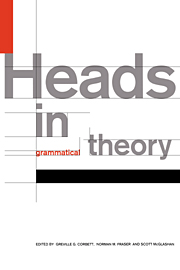Book contents
- Frontmatter
- Contents
- List of contributors
- 1 Introduction
- 2 The head of Russian numeral expressions
- 3 The phonology of heads in Haruai
- 4 Patterns of headedness
- 5 Head-hunting: on the trail of the nominal Janus
- 6 The headedness of noun phrases: slaying the nominal hydra
- 7 Head- versus dependent-marking: the case of the clause
- 8 Heads in discourse: structural versus functional centricity
- 9 Heads in Head-driven Phrase Structure Grammar
- 10 Heads and lexical semantics
- 11 Heads, parsing and word-order universals
- 12 Do we have heads in our minds?
- 13 Heads, bases and functors
- References
- Index
1 - Introduction
Published online by Cambridge University Press: 23 February 2010
- Frontmatter
- Contents
- List of contributors
- 1 Introduction
- 2 The head of Russian numeral expressions
- 3 The phonology of heads in Haruai
- 4 Patterns of headedness
- 5 Head-hunting: on the trail of the nominal Janus
- 6 The headedness of noun phrases: slaying the nominal hydra
- 7 Head- versus dependent-marking: the case of the clause
- 8 Heads in discourse: structural versus functional centricity
- 9 Heads in Head-driven Phrase Structure Grammar
- 10 Heads and lexical semantics
- 11 Heads, parsing and word-order universals
- 12 Do we have heads in our minds?
- 13 Heads, bases and functors
- References
- Index
Summary
Heads in grammatical theory
The majority of current grammatical theories refer explicitly to the head of a phrasal constituent. Yet while the term ‘head’ has entered the common currency of theoretical linguistics, this does not provide evidence of agreement on what it means. Nor does the term's long and varied career in linguistics guarantee that it identifies a notion which is not already identified by some other, more basic notion or interacting set of notions. The purpose of this volumev is twofold: first, it aims to uncover and make explicit the notion (or notions) behind the term ‘head’; second, it aims to investigate the status of the notion (or notions) in linguistic theory.
Most linguists would agree with the informal characterization that the head of a phrase is one of its constituents which in some sense dominates and represents the whole phrase. In an important paper published in the Journal of Linguistics in 1985, Zwicky drew attention to the fact that use of the term ‘head’ had been extended from syntax to morphology (for example, by Lieber, 1981; Williams, 1981; and Kiparsky, 1982) in spite of the fact that there was no generally agreed formal definition of the notion in syntax (though an important contribution had already been made by Gazdar and Pullum, 1981 and Gazdar, Pullum and Sag, 1982). Zwicky therefore set out to find a rigorous, generally acceptable definition for ‘head’. He proceeded by examining the following eight candidate criteria for the identification of a constituent as a syntactic head.
- Type
- Chapter
- Information
- Heads in Grammatical Theory , pp. 1 - 10Publisher: Cambridge University PressPrint publication year: 1993
- 1
- Cited by



